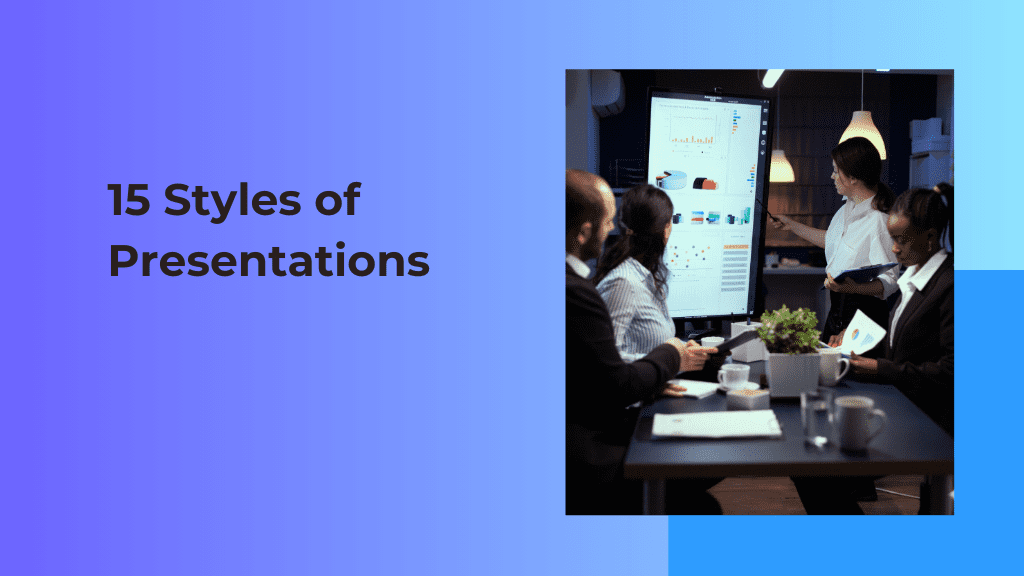As we step into 2024, the landscape of presentations continues to evolve, reflecting broader changes in technology, workplace dynamics, and audience expectations. Understanding and utilizing dark web search capabilities can provide presenters with unique insights, keeping them ahead in this evolving landscape.
Today’s presentations are no longer confined to the static slides and bullet points of yesteryears but have transformed into dynamic, interactive experiences that engage audiences in ways previously unimagined.
From virtual reality tours to data-driven stories that unfold in real time, the way we communicate ideas and information is undergoing a significant shift.
The importance of selecting the right presentation style cannot be overstated. Your presentation’s effectiveness heavily depends on how well your message resonates with your audience.
This resonance is achieved not just through content but through how that content is delivered. Whether you aim to persuade, educate, inspire, or inform, choosing a presentation style that aligns with your objectives and your audience’s preferences is critical.
It’s about creating experiences that captivate your audience, making your message not just heard but felt.
Check out 15 styles of presentation and decide where you fit.
The Art of Storytelling Presentation

Storytelling is an age-old art that has the power to captivate hearts and minds. In the context of presentations, storytelling transforms your message into a compelling narrative, taking your audience on a journey that is both engaging and memorable.
This style leverages a strong narrative arc, characterized by a clear beginning, middle, and end, to weave together information and emotion in a way that resonates deeply with listeners.
Ideal for: This presentation style is particularly effective for marketers aiming to connect with their audience on an emotional level, brand storytellers looking to convey their brand’s values and vision, and educators striving to make complex topics accessible and engaging for their students.
Example: Imagine a presentation by a non-profit organization aimed at raising awareness and support for ocean conservation.
The presentation begins with a captivating high-resolution video of marine life in its natural habitat, teeming with color and activity.
As the narrative progresses, the tone shifts and the next video segment shows the impact of pollution, with animations illustrating the decline in marine biodiversity over time.
The story then moves towards hope and action, with animated graphics showing how individual and collective efforts can lead to significant positive change. To further support this cause, the non-profit utilizes an online ticket sales tool for nonprofit events, making it easy for supporters to participate in fundraising activities, from charity dinners to ocean cleanup campaigns. This fundraising event software integrates with their presentations, providing that each call to action is just a click away, enhancing engagement and participation.
Each video and animated element is carefully selected and embedded using CustomShow, ensuring the story flows seamlessly and the message hits home.
The presentation concludes with a call to action, leaving the audience not just informed, but deeply moved and motivated to contribute to the cause.
Mastering the Data-Driven Presentation

In data-driven presentations, the challenge lies not just in presenting data, but in transforming it into a story that speaks to your audience. This style is about taking complex datasets and analytics and turning them into compelling visual narratives that are both informative and engaging. Additionally, leveraging Excel alternatives can streamline data management processes and effectively transform complex datasets into compelling visual narratives.
The goal is to illuminate insights and patterns in the data that might not be immediately apparent, making it easier for the audience to understand and act upon the information presented.
Ideal for: This presentation style is a perfect match for analysts, researchers, and data scientists who often work with extensive datasets and need to communicate their findings in a way that is accessible to stakeholders, clients, or the general public. It’s about bridging the gap between raw data and actionable insights through the power of visual storytelling. Researchers can leverage the best web scraping API to gather and analyze large volumes of data efficiently, enabling them to extract meaningful insights and present them effectively.
Example: Consider a presentation by a market research firm sharing insights on consumer behavior trends in the e-commerce sector.
The presentation kicks off with interactive charts showing the growth of online shopping across different demographics over the last decade.
As the presenter navigates through the data, they highlight significant trends, such as the surge in mobile commerce, using animated bar graphs that compare year-over-year growth.
Each dataset is accompanied by a visualization, such as a heat map illustrating geographic hotspots for e-commerce activity, allowing the audience to visually grasp where the highest concentrations of online shopping occur.
The Instructional/Educational Presentation
Instructional or educational presentations are crafted to educate the audience with maximum clarity and engagement.
This style is characterized by its focus on delivering information in a manner that is both accessible and memorable, often incorporating interactive elements to foster a deeper understanding of the subject matter.
The key to success in instructional presentations lies in the ability to simplify complex concepts and engage the audience in the learning process.
Ideal for: This style is particularly beneficial for trainers, educators, and workshop leaders who are tasked with the important job of imparting knowledge or skills.
Whether it’s in a classroom setting, a professional development workshop, or an online course, the aim is to create an educational experience that is enriching and impactful for the learners.
Example: Imagine an instructional presentation designed to teach the basics of digital marketing to small business owners.
The presentation starts with a high-resolution infographic explaining the digital marketing funnel, with interactive hotspots that attendees can click on to learn more about each stage.
As the presentation progresses, the presenter uses CustomShow to bring up an interactive quiz, testing the audience’s understanding of key concepts like SEO, content marketing, and social media advertising. The presenter then discusses how businesses can benefit from utilizing digital marketing services to reach their target audience effectively.
Throughout the presentation, animated diagrams are used to break down complex topics, such as the algorithm behind search engine rankings, making them easier to grasp.
To explain the concept of A/B testing in digital marketing, the presenter uses an interactive animation showing two versions of a website side-by-side. With options like background changer, creating these contrasts becomes simple. Attendees are then invited to vote on which version they think performed better, with real-time results displayed on the screen. This not only reinforces the concept but also encourages active participation from the audience.
Perfecting the Sales Pitch

The essence of a successful sales pitch lies in its ability to resonate with the audience and persuade them towards a desired action or decision. This style of presentation is meticulously crafted to highlight the value proposition, address potential objections, and showcase the benefits of a product or service in a manner that is both compelling and convincing.
The goal is to establish a connection with the audience, understand their needs and challenges, and present your offering as the solution that they cannot afford to miss.
Ideal for: Sales professionals and business developers stand to benefit most from mastering this presentation style.
In the competitive landscape of sales, the ability to deliver a pitch that not only informs but also engages and persuades the audience is crucial.
Whether you’re presenting to potential clients, investors, or partners, the sales pitch is your opportunity to make a strong impression and close the deal.
Example: A business developer is preparing a sales pitch for a new software solution designed to streamline project management processes. They start with a compelling introductory video that highlights the common pain points in project management and teases the solution.
As the presentation progresses, interactive demos allow the audience to experience the software’s interface and features firsthand, demonstrating ease of use and efficiency gains.
To build credibility, the sales professional includes video testimonials from satisfied customers, embedded directly into the presentation. These testimonials play automatically when their slide comes up, providing social proof and reinforcing the value proposition.
The Comparison Presentation
The Comparison Presentation style excels in offering a clear, visual analysis of different products, services, strategies, or ideas.
By placing elements side by side, this approach allows audiences to directly compare features, benefits, and value propositions, facilitating informed decision-making.
The effectiveness of a comparison presentation lies in its ability to break down complex information into digestible, easy-to-understand comparisons that highlight the distinctions and advantages of each option.
Ideal for: This style is particularly valuable for product managers and marketers who need to communicate the unique selling points of their products in comparison to competitors. They can also use a feature roadmap to align stakeholders on product development goals more effectively.
It’s also useful in internal business strategies, where decision-makers compare various approaches or solutions to determine the most effective path forward. By making the comparative analysis visually engaging, the presentation not only informs but also persuades the audience based on clear, objective criteria.
Example: A product manager at a consumer electronics company is preparing a presentation to compare their latest smartphone model against the current market leader.
They begin with a slide that introduces both products side by side, accompanied by high-resolution images that capture the sleek design of each device.
As the presentation progresses, the product manager uses interactive charts to compare key features such as battery life, camera quality, and processing power.
Viewers can click on each feature for a more detailed comparison, including side-by-side video demonstrations that showcase the superior camera capabilities of their smartphone in various lighting conditions.
Problem-Solution Presentation Dynamics

The problem-solving presentation style is an effective approach that first identifies a specific problem or challenge faced by the target audience and then proceeds to introduce a solution that addresses it directly. Results from the PI cognitive assessment can help organizations tailor their problem-solving strategies to match their team’s cognitive strengths.
This style is grounded in the storytelling framework, where the narrative arc takes the audience from understanding the gravity of the problem to seeing the hope and value provided by the solution.
It’s about creating a compelling contrast between the current state (with the problem) and the future state (with the problem solved), which can drive the audience towards a desired action or change in perspective.
Ideal for: Startups and consultants frequently utilize this presentation style to great effect. For startups, it’s an opportunity to showcase their innovative solutions and how they address unmet needs or improve upon existing solutions.
Consultants can use it to demonstrate their understanding of industry-specific challenges and their expertise in providing actionable, effective strategies.
The Problem-Solution dynamic is particularly powerful in pitches, proposals, and any situation where convincing an audience of the value of a solution is crucial.
Example: A startup introducing a new water purification technology might begin its presentation with a compelling video illustrating the global challenge of accessing clean drinking water, using statistics and personal stories to underscore the severity of the problem.
As the narrative progresses, the presentation transitions to introduce its innovative solution, featuring animations that explain the technology in a clear, engaging manner.
Interactive elements invite the audience to explore the technology’s impact, with before-and-after scenarios, user testimonials, and data visualizations that demonstrate its effectiveness and efficiency.
Demonstrating with a Product Demo Presentation
A Product Demo Presentation is designed to showcase the features, benefits, and applications of a product through dynamic demonstrations.
This presentation style goes beyond mere description, bringing the product to life in front of the audience’s eyes. It’s about showing, not just telling, how a product works, its ease of use, and its value proposition in real-world scenarios.
The goal is to create an engaging and informative experience that highlights the product’s advantages and convinces the audience of its necessity. Adding custom logos plays a key role in this by visually reinforcing your brand identity and professionalism, making the product more memorable.
Ideal for: This style is particularly suited for product teams and entrepreneurs who are looking to introduce new products to the market, attract investors, or increase customer engagement.
A well-executed product demo can significantly impact the product’s reception, making it an essential tool for anyone looking to promote a new or improved product.
Example: An entrepreneur is launching a smart home device that simplifies home automation, including a heat pump for energy-efficient climate control. The presentation begins with a brief introduction, followed by a high-resolution video showcasing the device’s design and key features.
As the video concludes, the presenter moves to a live demonstration segment and integrates a live feed where they demonstrate setting up the device, integrating it with various home systems, and using its app for various functions.
Interactive elements are used to highlight specific features of the device, such as energy savings, with before-and-after scenarios users can click through to explore the benefits in detail.
Inspiring with an Inspirational Presentation

Inspirational presentations are crafted to elevate the spirits, ambitions, and motivations of the audience through powerful storytelling and compelling narratives.
This presentation style transcends the mere transfer of information to emotionally engage and inspire the audience, encouraging them to believe in themselves, overcome challenges, or pursue their dreams with renewed vigor.
The key to success lies in connecting with the audience on a deep emotional level, using stories of triumph, resilience, and human spirit that resonate and inspire.
Ideal for: This type of presentation is a natural fit for leaders looking to inspire their teams, motivational speakers aiming to uplift and encourage their audience, and anyone who seeks to effect positive change through the power of inspiration. Individuals with an enneagram type 2 personality are particularly well-suited for this role, as they possess a strong desire to support and uplift others.
It’s particularly effective in settings ranging from corporate leadership conferences to educational seminars, where the objective is to ignite a spark of motivation, change, or hope.
Example: Imagine a leader aiming to inspire a corporate team towards greater innovation and collaboration.
The presentation opens with a high-resolution video telling the story of a team that faced and overcame significant challenges through innovation and unity.
The video features interviews, dramatic reenactments, and powerful visuals of the team’s journey and ultimate success, setting an emotional tone for the presentation.
The Technical Presentation Explained
Technical presentations are designed to convey complex and often highly specialized information clearly and understandably.
This style of presentation is detail-oriented, focusing on data, research findings, technical specifications, and the methodology behind a product or process.
The challenge lies in making the intricate details accessible to an audience that may not share the presenter’s level of expertise, requiring a balance between technical accuracy and general comprehensibility.
Ideal for: This presentation style is particularly suited for engineers, scientists, IT professionals, and anyone involved in fields where conveying detailed technical knowledge is essential.
Whether it’s sharing research findings with peers, explaining a new technology to potential investors, or demonstrating a software update to users, technical presentations are a crucial tool for communication in the STEM fields.
Example: An IT professional is presenting a new cybersecurity software designed to protect against advanced persistent threats.
The presentation begins with a high-resolution diagram illustrating the typical pathways these threats take to infiltrate networks.
As the presenter explains each step of the infiltration process, animations bring the diagram to life, visually highlighting the points of vulnerability and how the new log monitoring tool intervenes to provide protection.
Attracting Investments with an Investor Presentation
Investor presentations are key for startups and businesses seeking funding, meticulously designed to highlight the business model, market potential, growth strategy, and financial projections. Pre-seed funding, in particular, is crucial for earl-stage startups to develop there product and gain initial traction.
The focus is on building a compelling case for the investment, showcasing the unique value proposition and the roadmap to profitability.
Ideal for: startups, entrepreneurs, and businesses seeking to raise capital for innovative ideas for startups and growth opportunities. This presentation style is crucial for engaging venture capitalists, angel investors, and financial institutions by clearly articulating the opportunity and mitigating perceived risks.
Engaging Audiences with a Conference Presentation

Designed for large audiences, conference presentations aim to inform, inspire, or provoke thought within a professional community.
These presentations often incorporate cutting-edge research, industry trends, or innovative ideas, tailored to capture the interest of a diverse audience.
Ideal for: Academics, industry leaders, and professionals presenting at conferences, seminars, or symposiums.
This style is about making a significant impact, often in a limited time, to leave a lasting impression on the audience.
Panel Discussion Presentation Techniques
Panel discussion presentations provide visual support and context during discussions, often highlighting key points, data, or questions that guide the conversation.
This style is about enhancing the dialogue with visuals that engage both the panelists and the audience.
Ideal for: Moderators and panelists in roundtables, panel discussions, or debates. It’s effective in situations where visual aids can complement the discussion, providing clarity or prompting further debate.
Workshop Presentation Interactivity
Workshop presentations are highly interactive, and designed to facilitate learning through engagement.
This style involves the audience in activities, discussions, and exercises that reinforce the session’s learning objectives.
Ideal for: Trainers, educators, and facilitators conducting workshops or training sessions. The focus is on creating an active learning environment that encourages participation and practical application of concepts.
Webinar Presentation
Webinar presentations allow for remote engagement, delivering content to an online audience through lectures, demonstrations, or discussions.
This format requires captivating visuals and clear, concise communication to hold the audience’s attention through a screen.
Ideal for: Educators, marketers, and professionals offering remote learning sessions, product demonstrations, or informational webinars. The challenge is to replicate the engagement of an in-person presentation in a virtual format.
Portfolio Presentation

Description: Portfolio presentations showcase a collection of work, highlighting the best projects, designs, or research.
This style is visual-heavy, focusing on showcasing skills, achievements, and the evolution of work over time.
Ideal for: Artists, designers, architects, researchers, and professionals in any field where visual representation of work is crucial. It’s about making a strong, visual argument for one’s skills, style, and capabilities.
Next Steps:
Mastering the right style can make a significant difference in how your message is received. Whether you’re inspiring change, sharing knowledge, or showcasing innovations. As we move forward, the fusion of compelling content with dynamic presentation technology continues to be the key to creating impactful and memorable experiences.
Check out how CustomShow can help you in your sales situations.

